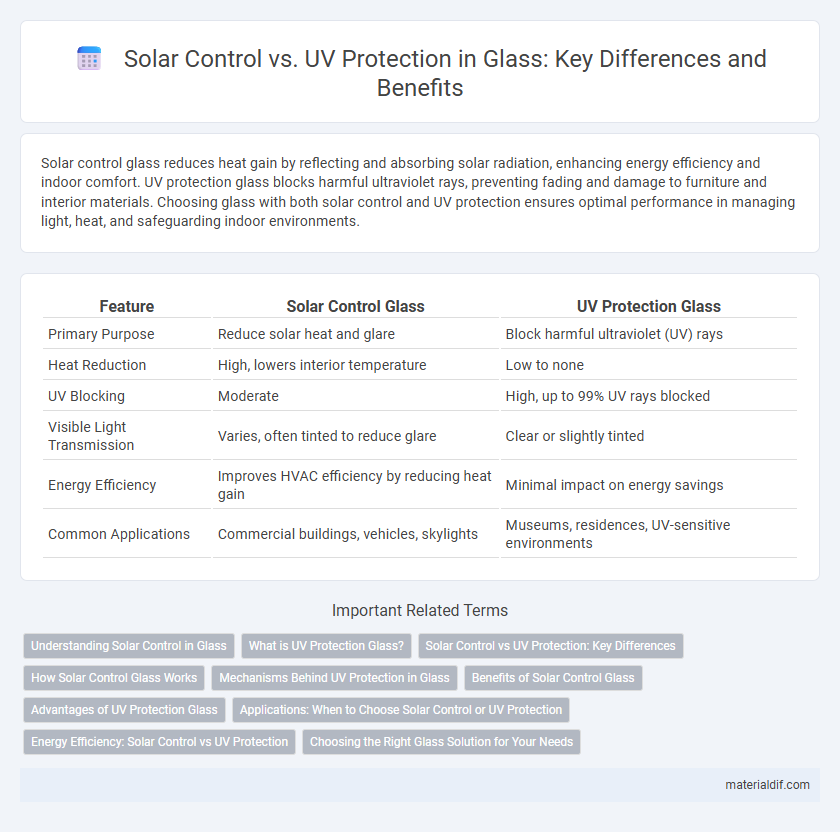Solar control glass reduces heat gain by reflecting and absorbing solar radiation, enhancing energy efficiency and indoor comfort. UV protection glass blocks harmful ultraviolet rays, preventing fading and damage to furniture and interior materials. Choosing glass with both solar control and UV protection ensures optimal performance in managing light, heat, and safeguarding indoor environments.
Table of Comparison
| Feature | Solar Control Glass | UV Protection Glass |
|---|---|---|
| Primary Purpose | Reduce solar heat and glare | Block harmful ultraviolet (UV) rays |
| Heat Reduction | High, lowers interior temperature | Low to none |
| UV Blocking | Moderate | High, up to 99% UV rays blocked |
| Visible Light Transmission | Varies, often tinted to reduce glare | Clear or slightly tinted |
| Energy Efficiency | Improves HVAC efficiency by reducing heat gain | Minimal impact on energy savings |
| Common Applications | Commercial buildings, vehicles, skylights | Museums, residences, UV-sensitive environments |
Understanding Solar Control in Glass
Solar control glass reduces heat gain by reflecting and absorbing solar radiation, helping to maintain indoor comfort and energy efficiency. Unlike UV protection glass that primarily blocks ultraviolet rays to prevent fading and health risks, solar control glass targets infrared and visible light to minimize solar heat penetration. This technology enhances building performance by lowering cooling costs and improving occupant comfort without compromising natural light.
What is UV Protection Glass?
UV protection glass is specially designed to block harmful ultraviolet (UV) rays from the sun, preventing skin damage and fading of interior furnishings. Unlike solar control glass, which primarily reduces heat and glare by reflecting or absorbing solar energy, UV protection glass specifically targets UV radiation, typically filtering out 99% or more of UVA and UVB rays. This glass is commonly used in residential, commercial, and automotive applications to enhance occupant safety and preserve materials exposed to sunlight.
Solar Control vs UV Protection: Key Differences
Solar control glass primarily reduces heat gain by reflecting or absorbing infrared radiation, enhancing energy efficiency in buildings. UV protection glass blocks ultraviolet rays to prevent material fading and skin damage without significantly affecting heat transmission. Understanding these distinctions is crucial for selecting the right glass type based on climate control needs versus health and preservation benefits.
How Solar Control Glass Works
Solar control glass reduces heat gain by reflecting and absorbing infrared radiation from sunlight, maintaining cooler indoor temperatures. It uses low-emissivity coatings that selectively filter solar energy while allowing visible light to pass through. This technology minimizes reliance on air conditioning, enhances energy efficiency, and improves comfort in buildings.
Mechanisms Behind UV Protection in Glass
UV protection in glass primarily relies on the incorporation of ultraviolet-absorbing additives or coatings that filter and block harmful UV rays from passing through. Solar control glass integrates these UV-blocking layers with reflective or tinted elements that reduce solar heat gain while maintaining visible light transmission. This dual mechanism not only prevents skin damage and fading of interior materials but also enhances energy efficiency by controlling heat infiltration.
Benefits of Solar Control Glass
Solar control glass significantly reduces glare and solar heat gain, enhancing indoor comfort while lowering air conditioning costs by up to 30%. It filters out harmful infrared rays without compromising visible light transmission, maintaining natural brightness and clear views. This glass also protects interiors from fading and damage caused by prolonged UV exposure, prolonging the lifespan of furniture and flooring.
Advantages of UV Protection Glass
UV protection glass blocks up to 99% of harmful ultraviolet rays, preventing skin damage and fading of interior furnishings. This type of glass enhances occupant comfort by reducing glare and minimizing heat transmission without compromising natural light. Its durability also protects vehicle and building interiors, extending the lifespan of upholstery, artwork, and flooring.
Applications: When to Choose Solar Control or UV Protection
Solar control glass is ideal for commercial buildings and residential environments aiming to reduce heat gain, improve energy efficiency, and enhance occupant comfort by reflecting or absorbing solar radiation. UV protection glass is essential in museums, retail stores, and homes to prevent fading and deterioration of furnishings, artwork, and sensitive materials by blocking harmful ultraviolet rays. Choosing solar control glass suits applications prioritizing thermal management, while UV protection glass is critical when preserving interior contents from UV damage is the primary concern.
Energy Efficiency: Solar Control vs UV Protection
Solar control glass significantly enhances energy efficiency by reducing solar heat gain, thereby lowering cooling costs in buildings. UV protection glass primarily blocks harmful ultraviolet rays without substantially affecting heat transmission, offering less impact on energy savings. Choosing solar control glass optimizes indoor temperature regulation and reduces reliance on air conditioning, making it the preferred option for energy-efficient glass solutions.
Choosing the Right Glass Solution for Your Needs
Selecting the right glass solution depends on whether solar control or UV protection is your priority. Solar control glass reduces heat gain and glare by reflecting and absorbing solar radiation, enhancing energy efficiency in buildings. UV protection glass blocks harmful ultraviolet rays, preventing interior fading and safeguarding occupants' skin without significantly affecting visible light transmission.
Solar Control vs UV Protection Infographic

 materialdif.com
materialdif.com